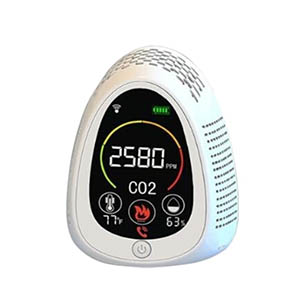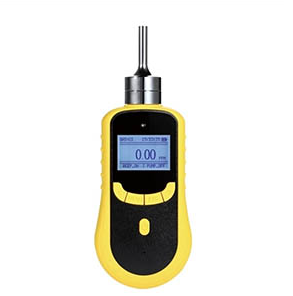Difference between Smoke Detectors and Carbon Monoxide Detectors
Are the smoke detectors and CO detectors the same? Smoke detectors and carbon monoxide detectors are two different instruments, and they have obvious differences in nature. Next, we will provide you with detailed information to explain their differences in different aspects.
Smoke Detectors Basics
Smoke detectors, also known as smoke detectors, are mainly apply in fire protection systems as well as the security systems. It is a typical device converted from space firefighting measures to civilian use. The smoke detector inside adopts ion smoke sensor, which is a kind of advanced technology, stable and reliable sensor. It is widely used in various fire alarm systems that its performance is far better than that of gas sensitive resistor fire alarms.
The smoke detector has a radioactive source Americium 241 in the inner and outer ionization chambers, and the positive and negative ions generated by ionization move to the positive and negative electrodes respectively under the action of the electric field. Under normal circumstances, the current and voltage of the inner and outer ionization chambers are stable. Once there is smoke fleeing outside the ionization chamber. Interfering with the normal movement of charged particles, the current and voltage will change, destroying the balance between the inner and outer ionization chambers. So the wireless transmitter sends out a wireless alarm signal, notifies the remote receiving host, and transmits the alarm information.
Carbon Monoxide Detector Basic
A carbon monoxide detector or CO detector is a device that detects the presence of carbon monoxide (CO) gas to prevent carbon monoxide poisoning. Carbon monoxide is a colorless, tasteless, and odorless gas. It is often called the "silent killer" because it is nearly undetectable to humans. In a study of Underwriters Laboratories, "60% of Americans fail to recognize any potential signs of carbon monoxide leaks in their homes". High concentrations of CO can be dangerous to humans depending on the amount present and the length of exposure. Smaller concentrations can be harmful over a longer period of time, while increasing concentrations require reduced exposure time to be harmful.
Carbon monoxide detectors are designed to measure carbon monoxide concentrations over time and sound an alarm before dangerous concentrations of carbon monoxide are reached in the environment, giving people enough warning to safely ventilate or evacuate the area. Detectors connected to some systems will also alert monitoring services so that emergency services can be dispatched if necessary.
Carbon monoxide detectors cannot be used as smoke detectors and vice versa, but people also sell combination smoke/carbon monoxide detectors.
Installation
Smoke Detector
The detection object is smoke particles to achieve fire prevention. In ATO, the CO2 smoke alarm detectors are combined with the function of fire alarm. The ignition process of a fire is generally accompanied by three combustion products: smoke, heat and light. In the early stage of the fire, due to the low temperature, most of the substances are in the smoldering stage, producing a lot of smoke. Therefore, smoke is one of the most important characteristics of early fires. In new construction, smoke detectors are required by local codes to be installed inside and outside every bedroom, and all smoke detectors must be connected directly to the wiring, interconnected and have battery backup. Some areas also require smoke detectors on stairs, main hallways and garages. A dozen or more detectors can be wired or wirelessly connected. If one detector detects smoke, the alarm will sound on all detectors in the network. Smoke can be detected even far from its location, increasing the likelihood of alerting occupants. It can be seen that wired interconnection is more practical in new construction than in existing construction.
- Due to its early smoke detection function, it can effectively detect the occurrence of fire in the early stage of fire, so it is widely installed in many important places. It is mainly suitable for fire alarms in homes, shops, dance halls, warehouses and other places.
- Places where early smoke is difficult to detect: warehouse/cold room/gymnasium/airport/theater.
- Places to avoid business interruption: communication network center/server computer room/command and dispatch center/precision medical instrument/MIS computer room.
- Places where maintenance work is difficult: prisons and detention centers/cable trenches/return air ducts/nuclear power plants or biochemical protection areas/operating rooms.
- Places requiring aesthetic or treasured items whose value cannot be estimated: museums/archives/historical buildings/technical facilities/galleries/cathedrals.
- Specific public places: theaters/churches/traffic terminals/nursing homes or nursing centers/hospitals.
Carbon Monoxide Detector
The detection object is carbon monoxide in the gas. Although carbon monoxide is thought to be denser than air, in reality carbon monoxide is barely lighter than air. This means that CO detectors should be placed at least 5 feet from the floor, or on the ceiling. NFPA recommends that people follow the manufacturer's instructions for proper placement of carbon monoxide gas detectors. For example, in new accommodation, carbon monoxide alarms should be installed in every rest area near gas supplies or in homes with garages. At the same time, each carbon monoxide detector has specific research and development functions, so different companies have various installation requirements for detectors. Please read the installation manual provided by each detector in detail.
- Since carbon monoxide is lighter than air, the carbon monoxide alarm should be installed 0.3m-1.2m away from the ceiling and within 1.5m of the air source radius. The household carbon monoxide alarm mounting bracket is fixed to the appropriate position on the wall, and mark the mounting holes position, drilling holes in the wall and fixing with screws.
- The carbon monoxide detector alarm should be installed in a place without shock, vibration, and strong electromagnetic field interference, and a clearance of not less than 0.3m should be left around to prevent the alarm from being affected when working. Carbon monoxide alarms should not be installed in dusty or greasy places. Oil, dust, or other chemicals will adhere to the alarm casing and the alarm can’t work normally.
- Do not install in places where blow strong wind from ceiling fans. Carbon monoxide detectors alarms are installed near windows and doors leading to the outdoors. Rapidly circulating air from a fan or fresh air outside can affect the alarm's response. Make sure the carbon monoxide alarm is installed where you can hear or see it. There is no humidity and high temperature around the installation, so as not to affect the detection.


